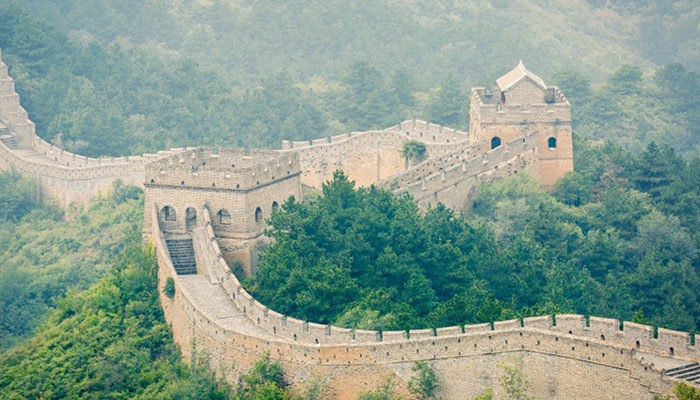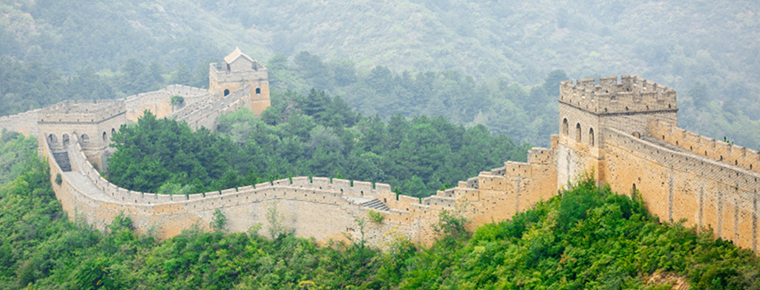The Great Wall
The Great Wall, also known as the Great Wall, is an ancient Chinese military defense project, is a tall, strong and continuous placanticline to limit the movement of the enemy riders. The Great Wall is not a single isolated wall, but a defense system with the city wall as the main body, combined with a large number of cities, barriers, pavilions and signs.

The history of the construction of the Great Wall can be traced back to the Western Zhou Dynasty, where the famous allusion "the princes of beacon fire opera" occurred in the capital of Haojing (now Xi'an, Shaanxi Province). During the Spring and Autumn Period and the Warring States Period, the nations fought for hegemony and defended each other. The construction of the Great Wall reached its first climax, but the length of the building was relatively short. After the unification of the six kingdoms, the first emperor of Qin connected and repaired the the Great Wall of the Warring States period. The Ming Dynasty was the last dynasty to overhaul the Great Wall. The the Great Wall that people see today is mostly built at this time.

Great Wall resources are mainly distributed in Hebei, Beijing, Tianjin, Shanxi, Shaanxi, Gansu, Inner Mongolia, Heilongjiang, Jilin, Liaoning, Shandong, Henan, Qinghai, Ningxia, Xinjiang and other 15 provinces and cities. Shaanxi is the most abundant province in China's the Great Wall. The the Great Wall is 1838 kilometers long. According to the national survey of the Great Wall resources conducted by the Department of cultural relics and surveying and mapping, the total length of the Great Wall of the Ming Dynasty was 8 851.8 km, the Qin and Han Dynasties and the early Great Wall exceeded 10,000 km and the total length exceeded 21,000 km.

In March 4, 1961, the Great Wall was declared the first batch of national key cultural relics protection units by the State Council. In December 1987, the Great Wall was listed as a world cultural heritage.


-
1.stired egg and tomato
Scrambled eggs with tomatoes, also known as tomato scrambled eggs, is a common popular dish among many people's families. The cooking method is simple and easy to learn, and the nutrition is reasonabl
Time 2018-10-27 -
2.Free and unfettered hu hot soup
The authentic Xiaoyao Town Hu Hot Soup, produced in Xiaoyao Town, Xihua County, Zhoukou City, Henan Province, is a famous snack in China
Time 2018-11-26 -
3.Mingsha Mountain Crescent Spring Scenic Area
Mingsha Mountain Crescent Spring Scenic Spot is located 5 kilometers south of Dunhuang City, Gansu Province. It covers an area of 312,000 square kilometers
Time 2018-12-12 -
4.Huizhou Seaside Hot Spring Resort
Huizhou Coastal Hot Spring is a large-scale comprehensive resort built according to the national standard of "AAAAAA" scenic spots and five-star hotels. It integrates tourism and vacation
Time 2019-01-19 -
5.Emei Chito
"A Mei Qituo" is the original ecological dance name of a group of Yi people. It is translated as "Girl Marriage Dance" in Chinese and originated from Sanbao Yi Township in Qinglong
Time 2019-03-28 -
6.Music of Confucius Festival in Liuyang Temple
The ancient music of offering sacrifices to Confucius in Liuyang Temple is a traditional folk music in Hunan Province. A list of the second batch of intangible cultural heritage in Hunan Province has
Time 2019-05-14 -
7.Qianshan Temple Music
Qianshan, located 20 kilometers southeast of Anshan City, Liaoning Province, is one of the most famous scenic spots in the country. In the northeast, Qianshan is as famous as Changbai Mountain in Jili
Time 2019-06-10 -
8.conjuring tricks
Conjuring tricks is one of the traditional Chinese acrobatics. Performers use agile methods to create audiovisual illusions, performing various objects, animals or water and fire and other rapid incre
Time 2019-07-01 -
9.Sintering Techniques of Xingyao Ceramics
Xingyao firing technology is a local traditional handicraft in Hebei Province. Xing kiln is a famous northern kiln in China. As early as the Northern Dynasty, Xing kiln began firing celadon and a smal
Time 2019-07-08 -
10.Cao Cao
Wei Wu Di Cao Cao (155 years - 220 March 15th), the name is Geely, the word Meng De, nicknamed hide. Prefectural governor of Yuzhou Qiao (today) Anhui Bozhou Person . Eastern Han Dynasty Outstanding i
Time 2019-09-07 -
11.Education in Panzhihua
By the end of 2018, Panzhihua had 2 ordinary colleges and universities, 56 ordinary secondary schools, 7 secondary professional schools, 60 primary schools and 194 kindergartens. There are 26617 students in Colleges and universities, 72372 students in secondary schools
Time 2020-12-14 -
12.History of Mianyang
Mianyang, located in the south of Mianshan mountain, was named Mianyang in 1913 according to the ancient meaning of "south mountain and North Water" as "Yang".
Time 2020-12-14